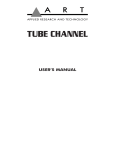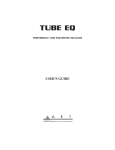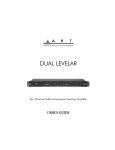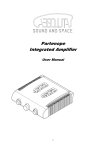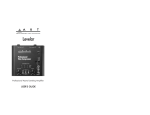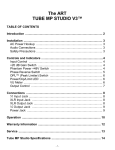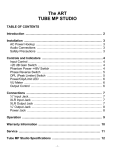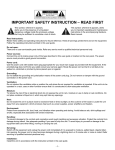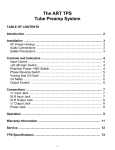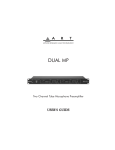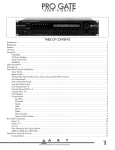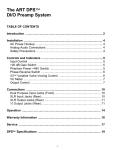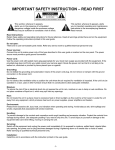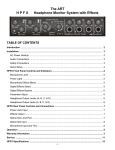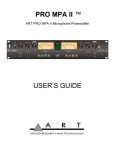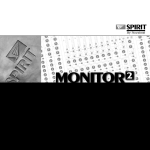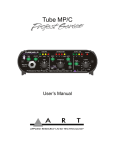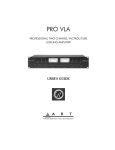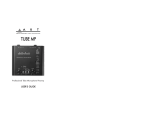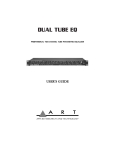Download Art Tube PAC User`s guide
Transcript
TUBE PAC PROFESSIONAL TUBE PREAMPLIFIER/COMPRESSOR USER’S GUIDE TABLE OF CONTENTS Introduction Registration Features Overview Setting Up Unpacking AC Power Hookup Audio Connections Installation Safety Precautions Powering Up Front Panel Controls and Indicators Gain Control Gain Switch Phantom Power Switch Tube Drive/ Gain Reduction Display Threshold Control Slope Switch Speed Switch Phase Switch Output Level Control Bypass Switch Rear Panel Connections Power Switch Input Output Applications Tube Replacement Specifications On-line Information Warranty Information Service Information 131-5004-101 1 2 2 3 4 5 5 5 5 5 6 6 6 6 7 7 8 8 9 9 9 10 10 11 11 11 11 12 13 14 15 16 16 Introduction Thank you for purchasing Applied Research and Technology’s Tube PAC. You’ve undoubtably noticed that the Tube PAC is as cool sounding as it looks. After getting familiar with the Tube PAC, you’ll realize what a great investment you’ve just made. The Tube PAC may be used everywhere! Anywhere you need level adjustments (gain or attenuation), and anywhere you need compression - you’ll be using the Tube PAC. Offering a superb level of sound quality, the Tube PAC will enhance the sonic textures of your audio system for years to come. Registration If you haven’t done so already, please take the time to fill out the User Registration Card for your purchase. Having you in our database allows us to keep you informed of updates, application notes, and new product introductions. It only takes a moment, and it will ensure you are constantly up to date with your purchase. Fill in the following for your future reference: Date of purchase: ___________________ Purchased From: ____________________ Serial Number: 131-________ 2 Features The Tube PAC is a unique product. It contains two independent award-winning circuit designs - one of the finest tube microphone preamplifiers available and one of the finest optical tube compressors available. Developed in partnership with studio and live sound engineers, the Tube PAC possesses a “sound” that is not available from any other product on the market - at any price! The Tube PAC was designed and constructed with the best components, assuring a lifetime of quiet, reliable performance. The Tube PAC offers: - The award-winning A R T “SOUND”! Tube-based mic/line preamplifier Tube-based optical compressor Hand-selected 12AX7a tubes VCA-less compressor circuitry = transparent dynamics control Unique tube drive and gain reduction metering Bypassable compression circuitry XLR balanced inputs and outputs 1/4” TS unbalanced inputs and outputs Custom extruded aluminum chassis +48V phantom power Phase reversal Over 70dB of gain Independent input and output level controls Detented rotary controls Compression and limiting ratios Selectable release time settings >90dB dynamic range Internal power supply One year warranty Designed and manufactured in the USA 3 OVERVIEW The Tube PAC (PreAmplifier/Compressor) is a multi-purpose tool for audio engineering and recording. Enclosed in a table-top (and 1/2 rack-able) chassis are two independent circuits featuring a tube-based analog preamplifier and a VCA-less, tube-based compressor with optical gain reduction control. Used as a mic/line preamp or as a DI (direct) box, the Tube PAC is designed to work seamlessly with any recording, sound-reinforcement, or electronic instrument setup. A R T’s Tube PAC circuitry is a hybrid design utilizing the latest, most advanced, solid-state and tube technology. Using a transformerless design throughout, the Tube PAC maintains exceptional signal integrity and extremely low noise. The compressor circuit follows the preamp. While the preamp is always active, the compressor may be bypassed. The preamplifier’s active balanced solid-state input provides extremely low noise and excellent CMRR. The 1/4” input has a high impedance, which prevents the loading of any device connected to it and makes the Tube PAC perfect for DI or line level applications. The preamplifier’s second stage 12AX7a tube runs on a regulated DC voltage providing an additional 40dB of gain. Our design causes the tube to overload before the input or output stage. This allows you to manipulate the tube gain to meet different sonic requirements. The compression circuit features a VCA-less design and utilizes optical electronics (Vactrol) coupled with a 12AX7 vacuum tube gain stage for superior musical performance. The compressor is soft knee by design. Although it is capable of providing a thoroughly “squashed” signal, it was designed to excel in areas where transparent and musical dynamics control is desired. The beauty of the optical/tube design is its ability to apply heavy amounts of compression without pumping and breathing like VCA-based compressors. In many cases you will hear the results of the com- 4 pression without hearing the compressor. SETTING UP Unpacking Your Tube PAC was packed with care at the factory. The shipping carton was designed to protect it during initial shipment. Please retain this carton for use in transporting the Tube PAC, or in the unlikely event that you need to return your Tube PAC for servicing. AC Power Hookup The Tube PAC has an internal power supply designed to operate at 100 to 125VAC, 50 to 60Hz. Units manufactured for use outside of the United States of America have been modified to comply with the required electrical specifications. Under no circumstances should the power cable be altered. If the cable becomes cut or damaged, discontinue its use and have it replaced before operating the Tube PAC. Audio Connections Audio connections to and from the Tube PAC are balanced XLR (Pin 2 Hot (+), Pin 3 Cold (-), Pin 1 Ground) and unbalanced 1/4” (Tip Hot (+), Sleeve Ground.) We recommend using only highquality cables equipped with the appropriate connectors. Installation The Tube PAC may be employed in a number of setups including: - Between a microphone and a mixer, digital multi-track recorder, DAT machine, hard disk recorder, or analog recorder. - In a mixer’s channel insert points. - Between a microphone and signal processors. - Between electronic musical instruments (synthesizers, guitars, bass, samplers, acoustic instruments with pickups) and other gear. 5 SAFETY PRECAUTIONS Warning: To avoid the risk of shock or fire, do not expose this unit to moisture. Do not remove metal panels from chassis parts. Removing the chassis from its cabinet parts exposes dangerous high voltages. There are no user-serviceable parts inside. Refer all servicing to qualified personnel. Note: If your power cord becomes damaged and must be replaced, always replace it with the proper type (3 prong.) POWERING UP When the rear panel power switch is turned on, the power indicator LED will illuminate. It is important to remember to turn the Tube PAC on before any monitoring levels or power amps are turned on. The Tube PAC has the ability to add over 60dB of gain to its input signal. This can cause the Tube PAC to produce a “thump” on power up and power down. Note: Like all tube-based equipment, the Tube PAC needs to warm up before being used. Allow one to two minutes for the tubes to reach proper operating temperature before using. If the Tube PAC fails to power up when the power switch is turned on, check to see that its power cord is plugged into an active outlet. If the unit still fails to operate properly, turn it off and unplug it. Then consult your dealer or A R T’s Customer Service department. FRONT PANEL CONTROLS & INDICATORS Gain Control The Gain control sets the amount of input gain of the Tube PAC. Turn the control clockwise to increase gain and counterclockwise 6 to decrease gain. Selection of the gain range is made with the +20dB gain switch. You may control two ranges of gain with this control, +26 to +60dB and +6 to +40dB. When setting the Gain control, refer to the 4 segment Tube Drive Array for a visual reference to the Tube PAC’s internal signal levels (applied gain). Hint: the “sweet” spot for the Tube PAC is when the second warm LED in the Tube Drive array is lit. Gain Switch Use the Gain switch to set the range of the Gain control. When the switch is in the out (0db) position the gain range is +6 to +40dB. Depressing the switch adds 20dB of gain. With the switch in, the gain range is +26 to +60dB. With most microphone applications you’ll find using the Tube PAC with the +20dB gain switch in is needed. Use the setting that best fits your application. Phantom Power Switch The Tube PAC can power any microphone needing +48 volts DC phantom power. Consult your microphone’s documentation to see if phantom power is required to power it. Phantom power is turned on and off with this switch and supplies power to pins 2 and 3 of the XLR input jack. It is best to have phantom power turned off when connecting microphones to the Tube PAC. Note: Be sure to turn down or mute the output of the Tube PAC when engaging or disengaging phantom power. Additionally, when disengaging, allow 30 - 45 seconds for the power to completely dissipate. Most microphones will make a sound like air leaking from a tire when phantom power is disconnected, but some can make some very nasty low rumbles and whines as well. Another Note: MOST dynamic microphones should not be affected or damaged if they are plugged into the Tube PAC when phantom power is turned on (we haven’t run across any). However, if the mic doesn’t need it, don’t use it. Some things are best left untested! 7 Tube Drive/Gain Reduction Display Four LEDs display how the tube gain is affecting the input signal. These LEDs are calibrated with the tube circuitry to give you an Note: these accurate representation of the tube’s output signal (N LEDs measure the signal level before the output level control). Use this meter as a visual for setting the Gain level. The first LED is labeled “Cln”. The tube is producing a clean output when this LED is lit. The next two LEDs are labeled “warm.” This is the optimal operating range for the Tube PAC. At this level, the tube is producing an output signal which most would term “warm” (Whatever you would like to call it is fine - simmering, toasty, etc.) You’ll find the output signal has an enhanced bottom to low mid quality with smooth high frequency detail. The last LED is labeled “Clip.” This LED will light approximately 6dB before audible distortion occurs. If this light flickers, do not panic. The unique design of the Tube PAC allows the tube to distort well before any other gain stage. When a tube goes into distortion it is a gradual process and tends to sound pleasing for a range before it turns into a distortion box. After some use you’ll find the “sweet spot” of the Tube PAC is with this light flashing fairly regularly. You may find a “clipped” level is suitable for some applications. Note: Use the Tube Character Array to aid in setting the Input Level Control. Threshold Control The Threshold control sets the point at which the compressor circuit will act on the input signal. Turning this control counterclockwise lowers the threshold (adding more compression to a signal). Turning this control clockwise raises the threshold. Setting the Threshold control is dependent on the Gain control. 8 The easiest way to set the threshold control is to start with the control fully clockwise. After setting the Gain control, slowly turn the Threshold control counter-clockwise (lowering threshold) until you see the yellow (0dB) Threshold LED light. Now adjust the control (either lower or higher) until you have the amount of compression you desire. Use the Gain Reduction meter as a visual guide to the amount of compression applied. Slope Switch In its “out” position, the Tube PAC’s compression ratio is an active 2.3:1 ratio. This means that for every 2.3dB over the threshold the input signal rises, the compressor’s output will change by 1dB. This is a very mild and musical compression ratio which is ideal for smoothing all types of signals. In its “in” position, the compression ratio is greater than 6:1. This is typically called “soft limiting” as it allows only a 1dB change in signal level for any signal reaching over 6dB over the set threshold. This setting is ideal for applications where exceeding a set level is not desirable (mixing, popping bass, digital recording, etc.). Speed Switch The position of the Speed switch selects the release characteristics of the Tube PAC’s compressor. The “out” position allows the compressor to recover quickly once the signal falls below the threshold. The “in” position allows the compressor to adjust itself depending on the characteristics of the input signal. Use the “fast” setting when the signal has repetitive, consistent characteristics (kick drum, snare, vocals, etc.). Use the “auto” setting when the signal has varying characteristics (long decaying notes alternating with quick notes, mix material, etc.). Phase Switch The Phase switch is provided to reverse the phase of a signal. This switch works on Pins 2 and 3 of the XLR Output jack. The Phase 9 switch also reverses the polarity of the 1/4” output jack. In the Normal (out) position, the signal is in-phase. In the Reverse (in) position, Pins 2 and 3 are reversed as the signal is changed to 180 degrees out of phase. In multiple microphone applications, the placement of the microphones can affect the phase of a signal. If two microphones pick up the same signal from different locations, the result can be a hollow or frequency “shifted” sound. In some cases it may sound as if an instrument disappears if it happens to be 180 degrees out of phase. Depressing the Phase switch can remedy this problem. Likewise, if a microphone cable is wired incorrectly, when used with a properly wired cable the signal will be out of phase. Note: for single microphone applications, switching the phase switch in and out will produce little to no change in the output signal. Output Level Control The Output Level control sets the output level of the Tube PAC. When the control is fully counterclockwise, there is no output. Turning the control clockwise increases the level of the output to a maximum of +10dB of gain. When setting the Output Level control, refer to the level meter on your recorder or mixer. Bypass Switch A Bypass switch is included on the Tube PAC to enable you to remove the compressor from your signal chain. When set to its “in” (bypass) position, signal is allowed to pass from the preamp circuitry to the output jacks with no compression. The LED will glow red when Bypass is engaged. This informs you that the compressor is bypassed. In its “out” position, the compressor is active. Use the Bypass switch when setting the Tube PAC’s Output Level to achieve unity (no boost or cut) gain. Unity gain is achieved when the active level is the same as the bypassed level. 10 REAR PANEL CONNECTIONS Power The Power switch supplies and removes power from the unit. The Tube PAC should be turned “on” only when all monitor levels are turned down, or off, to protect against any “thumping” caused by high gain settings. Likewise, the Tube PAC should be turned “off” after turning all monitor levels down. Input and Output Connections The Tube PAC’s XLR connectors follow the AES standard: Pin 1 = Ground, Pin 2 = Hot (+), Pin 3 = Cold (-). The unbalanced 1/4” phone jacks are typical Tip = Hot (+), Sleeve = Ground. Input One input jack per channel should be used at a time. However, because of its design, the Tube PAC can be hard-wired without having to disconnect the XLR inputs when using the 1/4” jacks. If no load is placed on the XLR input (no instrument or microphone connected) the 1/4” jack will function as if there was nothing connected to the XLR input. Output Both balanced and unbalanced output connections may be used simultaneously. This is particularly useful when using the Tube PAC as a direct box for instruments or line level signals. Note: If you experience a hum when using both output connectors simultaneously (one to the console and one to an instrument amp), a ground loop may be the problem. To remedy this problem, disconnect the ground wire (pin 1) from the XLR cable 11 plugged into the Tube PAC’s output (or use a ground-lifted audio cable). This interrupts the ground path and therefore breaks the loop. APPLICATIONS The main application of the Tube PAC is as a microphone preamplifier and compressor. To use the Tube PAC as a mic or line preamplifier only, simply press the Bypass switch to bypass the compression circuitry. Plug any microphone directly into either input and set the input and output controls to provide an appropriate level into the next stage of your system. The Tube PAC is ideal for use as a DI box. Plug the instrument into either input and use the XLR, 1/4, or both outputs to connect to your recorder, board, or PA system. Experiment with different input level settings for different textures. In most cases the Tube PAC offers superior performance to the onboard preamp on your console. To use the Tube PAC instead of your on-board preamp, simply connect the output of the Tube PAC to the line input of your mixer’s input channel. Note: you can con- 12 nect the XLR output jack of the Tube PAC to the XLR input of your mixer, however most affordable mixers do not allow you to bypass their internal preamp when using the XLR jack. You will cause no harm to either unit when doing this but you will probably experience slightly higher noise. This is due to the fact that you are now preamplifing your mixer’s preamp. Mastering (2-mix processing) Because of its low noise and excellent tonal qualities, the Tube PAC is ideal to run mixes through before recording to DAT or cassette. Used as a mastering device, the Tube PAC is capable of adding warmth and gentle tube compression to the incoming signal. Low noise, compression and variable Input and Output level controls make the Tube PAC ideal for level matching material in post production situations. Special Effects For industrial, metal, or just “flavor” textures, experiment with the Tube PAC. Overdriving the preamp and compressor circuitry can add interesting textures when blended with vocals and other instruments. Placing signals purposely out of phase can also yield interesting results. No harm will come to the Tube PAC with this type of experimentation. However, be sure to have output and monitoring levels turned DOWN before “testing” the sound. Remember, you have a great amount of gain available in the Tube PAC! TUBE REPLACEMENT The Tubes in your Tube PAC should last for many years. The tubes used in your unit are hand-sorted for performance. In the event that you need to replace them, A R T suggests that you do so with tubes available from A R T. These are matched to the Tube PAC and will yield consistent sonic results. You can replace the tubes with other brands, however A R T has no responsibility for the resulting sound quality. They may sound better, they may sound 13 worse. The choice is yours. Please realize that unauthorized alterations to the Tube PAC will result in voiding the warranty. A R T Tube PAC SPECIFICATIONS Dimensions 5.25"D x 8.5"W x 1.65"H Weight 6.0 lbs Maximum Gain XLR to XLR 70dB 1/4” to 1/4” 67dB Phantom Power +48v DC (switchable) Compression Ratio 2.3:1 (comp)/ 6:1 (lim) Attack Time 6.5ms Release Time 200ms (fast), 70ms-1sec (auto) Equivalent Input Noise -129dBu (XLR to XLR, ‘A’ weighted) Dynamic Range >90dB (no weighting) Input Impedance 1.67k ohms (XLR), 1M ohm (1/4”) Output Impedance 600 ohms (XLR), 300 ohms (1/4”) Maximum input Level +15dBu (XLR), +21dBu (1/4”) Maximum Output Level +27dBu (XLR), +22dBu (1/4”) CMRR 90dB (typical) THD <0.1% (typical) Tubes Two Hand-Selected 12AX7a Power Requirements 100-125 VAC, 16W (Export units configured for country of destination) A R T retains a policy of constant product improvement. A R T reserves the right to make changes in design or make additions to or improvements upon this product without any obligation to install the same on products previously manufactured. In other words, specifications are subject to change without notice. Designed and manufactured in the United States of America. Applied Research and Technology, Inc. 215 Tremont Street Rochester, NY 14608 USA (716) 436-2720 (Phone) (716) 436-3942 (FAX) 14 WE’RE ON-LINE! For Product information, questions, applications, tips, answers and general discussion with A R T employees look for A R T on the Internet.. Look for the A R T folder on America Online in Craig Anderton’s Stage Studio and Sound (keyword “SSS”) under the Manufacturer Supported Forums. Email us at [email protected] Look for the A R T supported area in the MIDI Forum B area on CompuServe (Go MIDI). CompuServe address: 76702,3700. Email us at [email protected] Check out our Web Page at: http:\\www.artroch.com 15 WARRANTY AND SERVICE INFORMATION Limited Warranty Warranty service for this unit will be provided by Applied Research and Technology, Inc. in accordance with the following warranty statement. Applied Research and Technology, Inc. (A R T) warrants to the original purchaser that this product is free from defects in workmanship and materials for a period of one year from the date of purchase. A R T will, without charge, repair or replace, at its option, defective product or component parts upon prepaid delivery to the factory service department or an authorized service center, accompanied by proof of purchase date in the form of a valid sales receipt. EXCLUSIONS: This warranty does not apply in the event of misuse or abuse of the product or as a result of unauthorized alterations or repairs. This warranty is void if the serial number is altered, defaced or removed. A R T reserves the right to make changes in design and make additions or improvements upon this product without any obligation to install the same on products previously manufactured. A R T should not be liable for any consequential damages, including without limitation damages resulting from the loss of use. Some states do not allow limitation of incidental or consequential damages, so the above limitation or exclusion may not apply to you. This warranty gives you specific rights and you may also have other rights which vary from state to state. For products purchased outside the United States, service will be provided by an authorized distributor of Applied Research and Technology, Inc. products. SERVICE The following information is provided in the unlikely event that your unit requires service. Use this procedure to return units in the United States only. For service outside the United States, please contact your authorized A R T distributor. 1) Be sure the unit is the cause of the problem. Check to make sure the unit has power supplied, all cables are connected correctly, and the cables themselves are in working condition. 2) If you find the unit to be at fault, write down a description of the problem, including how and when the problem occurs. 3) Call the factory for a Return Authorization (RA) number. 4) Pack the unit in its original carton or reasonable substitute. The packing box is not recommended for a shipping carton. Put the packaged unit in another box for shipping. Print the RA number clearly under the address. 16 5) Include with your unit: a return shipping address (we cannot ship to a P.O. Box), a copy of your purchase receipt, a daytime phone number and the description of the problem. 6) Ship the unit to: Applied Research and Technology, Inc. 215 Tremont Street Rochester, NY 14608 Atten: Repair Department R.A.# _______________ 7) Contact our Customer Service department at (716) 436-2720 for your Return Authorization number or questions regarding your repair. Customer Service hours are Monday through Friday 9:00AM to 5:00PM Eastern time. ©1997 Applied Research and Technology, Inc. 17



















